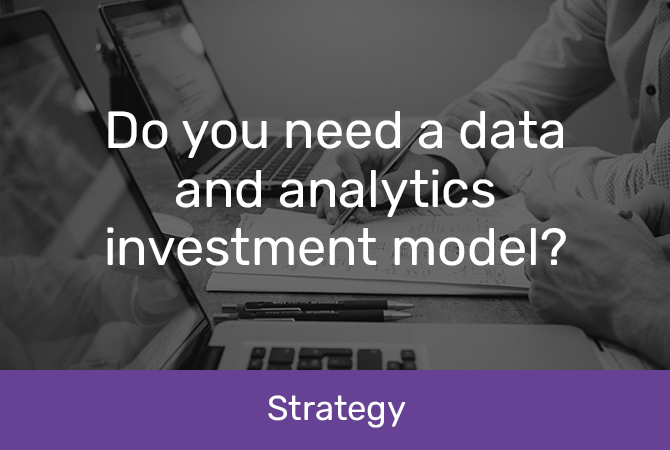Do you need a data, AI and analytics investment model?
A robust model helps you prioritise and justify analytics projects
You’ve seen it happen. A promising data project gets off the ground, then fizzles when priorities shift, budgets tighten, or stakeholders lose interest. You’ve watched colleagues quietly distance themselves from initiatives they once championed. You’ve read about the benefits – better insights, more thoughtful decision-making, new growth opportunities – but you struggle to turn nods of agreement into action. Not because the value isn’t real, but because getting the buy-in across a business that’s stretched thin is one of the hardest parts of any data or AI journey.
But here’s the truth: doing nothing is the greatest risk of all. While your organisation adds to the “maybe later” pile of projects, your competitors are moving. They’re forecasting with confidence, reducing costs, and capturing market share (some of it likely at your expense).
So, what’s the solution? You don’t just need a data strategy and a data budget – although those are important. You need a clear data, AI and analytics investment model that helps you decide how best to use your budget and how potential projects align with your overall strategy. Think of an investment model as a framework that guides decision-making and – crucially – justifies it.
What is a data and analytics investment model?
In large organisations, data, AI and analytics projects are expensive and time-consuming – not to mention resource-heavy. As a result, they can get bogged down in endless discussions and disagreements between teams and leaders. Should you greenlight that flashy social media analytics project for the marketing team, or start work on an inventory management initiative? Do you need a dashboard with a central view of each customer or a predictive model to help you identify customers at risk of churn?
A data, AI and analytics investment model is a business case and decision framework that helps you look at potential projects with an eye on value, risk, feasibility, impact and alignment with your wider strategy. An investment model sits alongside your data strategy and your budget.
Here’s how they work together:
Data strategy – defines your data, AI and analytics goals, what to do to reach them, and steps that will get you there.
Data budget – establishes how much you will spend on data, AI and analytics initiatives.
Analytics investment model – helps decide which projects to fund, to align with your data strategy and the constraints of the data budget.
Download our free guide to Data Strategies today.
The value of a data, AI and analytics investment model
If you’re thinking, “Things are fine without an investment model – we’ve made it this far”, that’s entirely fair. You’ve been making decisions, projects have started – eventually – and you’re spending your data budget. So why add an extra step? Because an ad hoc approach to data spending can lead to poorly-planned projects, wasted work and hit-or-miss outcomes. And that ultimately proves to be more expensive in the long run.
Here’s what can happen without a clear framework to guide decisions:
Projects don’t quite fit – You choose data initiatives that don’t align with your strategy or solve your most pressing issues, so they fail to deliver or simply fizzle out. Either way, it’s a waste of time and budget.
Initiatives struggle to launch – Sometimes, no framework for decision-making means no decisions are made. Nobody knows which data project should come first, so potential initiatives stay in the too-hard basket and nothing is done.
Your data budget goes to waste – Investing in the wrong projects or overestimating the ROI of data initiatives can mean that you don’t get the full value of your data budget.
It’s hard to get everyone aligned on new projects – With no shared understanding of what makes an initiative appropriate and investment-worthy, stakeholders disagree on the best projects to fund.
On the flip side, here’s what happens when you add an investment model to the mix:
Clear goal-setting and alignment – Everyone understands the decision-making process and the purpose of each data project.Continuity and momentum – Potential projects are assessed promptly, so they can move forward. Rather than indecision and stalled projects, you get forward momentum.
Stakeholder confidence – You can defend your decisions with evidence rather than just gut feel, and getting executive buy-in is easier.
What does a robust data, AI and analytics investment model look like?
A data, AI and analytics investment model is essentially a set of criteria used to judge a proposed project or idea. It’s about looking at an initiative from every possible angle, so you can accurately assess its potential and compare it to other proposals.
Key questions:
How well is this idea/initiative aligned with our data strategy?
Any new data project needs to line up with the goals, priorities and policies laid out in your data strategy.
What is the ROI?
ROI is a factor in every new investment – and in every business decision. The same goes for data initiatives. You want to know that all the money and time you pour into a project will result in a return. If it’s impossible to estimate the ROI of a project, it could be a red flag.
How much will it cost to deliver?
Implementation, build, long-term maintenance – the cost of an analytics initiative can vary widely. Understanding the full range of costs, in terms of tech, human resources and outside support, is key (and it helps you figure out the ROI, as well.)
What are the risks?
Every project comes with risks – from overspending and waste to security breaches or damage to your brand. The key is assessing first so you have a clear understanding of potential risks and a plan to mitigate the impact if something does go wrong.
Are we ready and able to deliver this?
Data projects need to be attainable as well as valuable. Do you have the internal IT capacity to build and deliver a new initiative? Is your data access and quality at the right level? Some projects will need significant pre-work and planning before they can kick off.
Can we scale it, and can it be reused to deliver other things across the business?
Does this idea apply to one small part of your business, or could it scale and flex to deliver value in other areas? This helps you assess long-term value as well as immediate gains.
Who owns the project/idea?
When one person or team is accountable for driving an initiative, it’s far more likely to get off the ground and keep moving. It’s easy for projects with no clear ownership or accountability to lose momentum as people get caught up in other parts of their jobs.
How will we measure success?
KPIs depend on the objectives and structure of the project. They could include revenue metrics like conversions or customer lifetime value, customer engagement metrics like click-through-rates or sales frequency, and operational metrics such as inventory movement and operational costs.
How will we keep the project on track?
Got a great project? You should have a step-by-step plan for implementation as well as mechanisms to keep it on track. These could be regular check-ins and reporting from your implementation team, data governance policies to ensure you’re accessing and storing data safely, and team meetings to measure progress.
It’s also a good idea to have people at several levels who are accountable for progress. For example, you could have an IT team lead who ‘owns’ the project or initiative, along with a C-level exec to take regular temperature checks and reassign work if the project owner leaves.
Why enlist the help of data analytics experts?
It’s understandable if your internal team is overwhelmed. Managing a modern data ecosystem is no small feat – particularly if it involves brand-new AI-driven solutions. That’s where bringing in experts can help.
At Datamine, we don’t believe in off-the-shelf platforms or throwaway tech experiments. We help from the ground up, working with your team to develop a clear data strategy and budget that works for your business. We can also help you create an informative data investment model to assess and prioritise data projects. If we’re developing a data initiative for you, we start by asking, “What’s the commercial value of solving this problem?” Then we help you work through your investment model to build a rock-solid case for investment.
We know the value of data projects – but we’ve also seen too many that end in failure or waste.
Every solution we deliver is:
- Customised to your context
- Tied to a measurable business outcome
- Designed to scale when you’re ready
If you’ve experienced failed data projects before, you’re not alone. But expert guidance, clear goals and shared ownership can change the trajectory.
Explore Datamine’s suite of solutions to understand what’s possible for your business and its data.
Data, AI and analytics investment model case studies
What does a dedicated data investment model look like in practice? Here’s how several leading organisations across different sectors have achieved measurable ROI by backing their analytics strategies with the proper support and budget.
Retail: Personalisation that pays off
A large Australian retailer partnered with Datamine to improve how it connects with its customers. Using machine learning and advanced segmentation, it grouped customers based on their behaviour and preferences, and used those insights to tailor its marketing. The result? Loyalty campaigns got 30% more engagement, and more customers came back to shop again.
Insurance: Predicting and preventing claims fraud
For one of New Zealand’s top insurance providers, fraud detection was a growing concern. Datamine developed predictive models that identified high-risk claims before processing them, enabling investigators to intervene sooner. The project led to millions saved annually and faster resolutions for genuine claims.
Media: Data-driven ad sales
A large media company had a mountain of fragmented audience data. By working with Datamine to unify and structure this data, it could use real-time insights on viewing habits and demographic preferences to offer advertisers more targeted packages, resulting in a 20% uplift in ad revenue.
Telco: Churn forecasting at scale
When a national telco saw its churn rate climbing, it turned to Datamine to get ahead of the curve. After integrating and cleaning legacy systems, Datamine developed churn forecasting models that accurately identified high-risk customers. The company deployed retention strategies, saving over $10 million in potential lost revenue.
Make data investment pay off with Datamine
You don’t have to go all-in on analytics tomorrow. But you do need to start laying the groundwork today.
Because while your team hesitates, someone else’s CFO just signed off on a six-month pilot that’s already showing ROI. Their next move? Pricing your product out of the market, reaching your customers before you do, or offering a better, faster service because they can see what’s coming.
By supporting strategy and budget with a framework for decision-making, you can gain ongoing, measurable ROI from your projects, too.
What’s next?
If you’re ready to create a data and analytics investment model that works, we’re here to help you through the process. Contact the Datamine team to see how we can support your next initiative.





















































